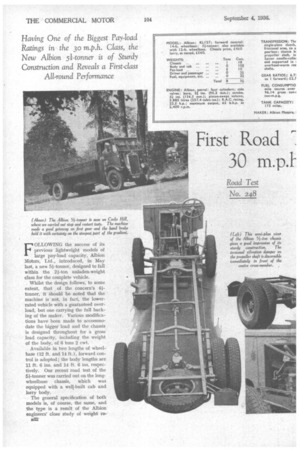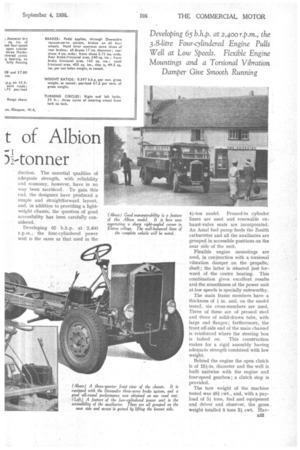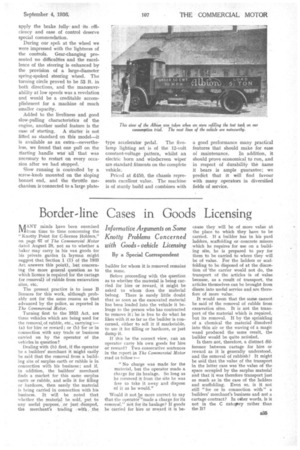First Road t of Albion -1 x-tonner 30 m.p.t
Page 46

Page 47

Page 48

Page 49

If you've noticed an error in this article please click here to report it so we can fix it.
FOLLOWING the success of its previous lightweight models of large pay-load capacity, Albion Motors, Ltd., introduced, in May last, a new 5i-tonner, designed to fall within the 2i-ton unladen-weight class for the complete vehicle.
Whilst the design follows, to some extent, that of the concern's 41tonner, it should be noted that the• machine is not, in fact, the lowerrated vehicle with a guaranteed overload, but one carrying the full backing of the maker. Various modifications have been made to accommodate the bigger load and the chassis is designed throughout for a gross load capacity, including the weight of the body, of 6 tons 2 cwt.
Available in two lengths of wheelbase (12 ft. and 14 ft.), forward control is adopted ; the body lengths are 11 ft. 6 ins. and 14 ft. 6 ins. respectively. Our recent road test of the 51-tonner was carried out on the longwheelbase chassis, which was equipped with a well-built cab and lorry body.
The general specification of both models is, of course, the same, and the type is a result of the Albion engineers' close study of weight re
B32
duction. The essential qualities of adequate strength, with reliability and economy, however, have in no way been sacrificed. To gain this end, the designers have produced a simple and straightforward layout, and, in addition to providing a lightweight chassis, the question of good accessibility has been carefully considered.
Developing 65 b.h.p. at 2,400 r.p.m., the four-cylindered power Unit is the same as that used in the 41-ton model. Pressed-in cylinder liners are used and renewable exhaust-valve seats are incorporated. An Ama.1 fuel pump feeds the Zenith carburetter and all the auxiliaries are grouped in accessible positions on the near side of the unit.
Flexible engine mountings are used, in conjunction with a torsional vibration damper on the propelle.: shaft ; the latter is situated just forward of the centre bearing. This combination gives excellent results and the smoothness of the power unit at low speeds is specially noteworthy.
The main frame members have a thickness of in. and, on the model tested, six cross-members are used. Three of these are of pressed steel and three of solid-drawn tube, with large end flanges ; furthermore, the front off-side end of the main channel is reinforced where the steering box is bolted on. This construction makes for a rigid assembly having adequate strength combined with low weight.
Behind the engine the open clutch is of 13i-in. diameter and the well is built unitwise with the engine and four-speed gearbox; a clutch stop is provided.
The tare weight of the machine tested was 481 cwt., and, with a payload of 5i tons, fuel and equipment and driver and observer, the gross weight totalled 8 tons 3i. cwt. Hay ing checked up on these weights, we proceededto -ptitthe vehicle through its paces, our first test being to investiga4 the machine's hill climbing capabilities.
For this purpose we chose Brockley Hill, near Edgware, an acclivity that is calculated to bring out the best—or worst—of a vehicle in this class. The steep section of the hill, which has a gradient of approximately 1 in 84 and is about a quarter of a mile long, is approached by a long gradient, which pulls the speed down and effectively prevents any rushing of the steep section.
The Albion tackled this climb in
what might be described as a thoroughly confident and capable manner. The engine pulled well in top gear on the lower slopes until, just opposite the milestone which marks the beginning of the steep section, a change to third gear was made at a 'speed of 15 m.p.h. Shortly after this, as the gradient hardened, second gear was required, and, finally,• on the steepest part first gear was engaged, the minimumspeed recorded being 6 m.p.h.
The good time of 1 min. 18 secs. for the 'quarter-mile was recorded,: and despite an atmospheric temperature of nearly 80 degrees F:, the temperature of the cooling water on the completion of the ascent was only 196 degrees F.
On Cocks Hill, the maximum gradient of which is 1 in 6, we carried out stop-and-restart tests. Points revealed were that the hand brake holds the vehicle with complete security and that the long lever on the driver's right-hand side is so placed as to give easy operation under the most difficult conditions. The machine got away with ease on the 1-in-6 gradient and ample power was available in the lowest ratio. Several restarts on this hill confirmed our view that no element of luck had entered into the success of_ our first effort.
The rear-axle ratio of el to 1 has B.34
been well chosen and enables a firstclass performance to be put up in hilly districts. At the same time, on level roads a gOod turn of speed is available without undue " revving " of the engine in top gear.
For our consumption test we started from the aerodrome at Hatfidd, proceeding for some eight miles up the Great North Road. Our object was to cover an out-and-return route, but in this we 'were, thwarted to some extent by road repairs on the long hill leading past Welwyn Garden City.
For over a mile third gear was needed—and on occasions " second 7 —since it fell to our lot to follow a stream of slow-moving traffic. In consequence, the result obtained on the first gallon of petrol in the test tank was not held to be representative of the Albion's capabilities in this direction.
We, therefore, continued our consumption test throughout the return journey to the' Albion concern's service station at Willesden, and, over a distance of 35.3 miles, which included several hills and heavy traffic conditions, exactly three gallons of petrol were consumed. This gives a return of 11.76 m.p.g., which is a creditable performance, in view of the load and the conditions pertaining during our test.
An accompanying graph shows the results obtained during our acceleration tests. The good pulling power of the engine at low speeds led us to believe that an excellent top-gear performance would be revealed, and this proved to be the case. The curves represent the mean of two runs taken in opposite directions, and it will be seen'that from 10 m.p.h. in top gear the machine pulled away steadily and rapidly up to its maximum.
Good figures were returned on our brake tests, the foot-operated system —which is of the Dewandre threeservo type—being well up to modern requirements. The pedal pressure required is light and retardation is smooth, with a marked freedom from snatch.
Incidentally, we tried out the foot brake with the -engine stopped, and it proved quite effective without the need for undue pressure on the pedal. The hand brake was well up to its work, and, as previously mentioned, the lever is remarkably acces
sible. Small effort is required to apply the brake fully and its efficiency and ease of control deserve special commendation.
During our speli at the wheel we were impressed with the lightness of the controls. Gear-changing presented no difficulties and the excellence of the steering is enhanced by the provision of a large-diameter spring-spoked .steering wheel. The turning circle proved to be 53 ft. in both directions, and the manoeuvrability at low speeds was a revelation and would be a creditable accomplishment for a machine of much smaller capacity.
Added to the liveliness and good slow-pulling characteristics of the engine, another useful feature is the ease of starting. A starter is not fitted as standard on this model—it is available as an extra—nevertheless, we found that one pull on the starting handle was' all that was necessary to restart on every occasion after we had stopped.
Slow running is controlled by a screw-knob mounted on the sloping bonnet end, and the throttle mechanism is 'connected to aiarge plate
type accelerator pedal. The five lamp lighting set is of the 12-volt constant-voltage pattern, whilst an electric horn and windscreen wiper are standard fitments on the complete vehicle.
Priced at £450, the chassis represents excellent value. The machine is of sturdy build and combines with of maintenance. In addition, it should prove economical to run, and in respect of durability the name it bears is ample guarantee; we predict that it will find favour with many operators in diversified fields of service.




























































































